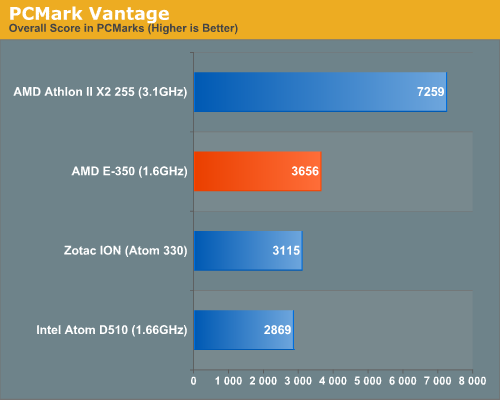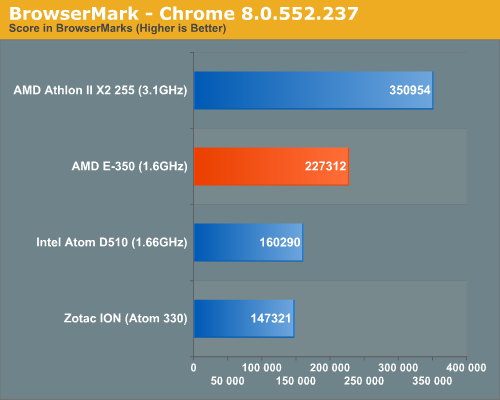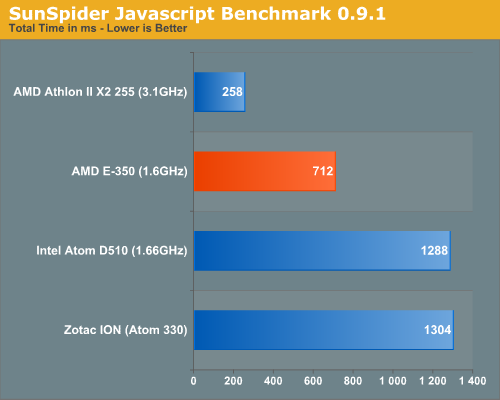The Brazos Review: AMD's E-350 Supplants ION for mini-ITX
by Anand Lal Shimpi on January 27, 2011 6:08 PM ESTGeneral Performance: In Between Atom and Athlon II
Atom may be efficient and fast enough to run a smartphone OS, but it absolutely chugs on Windows 7. The seat of the pants feel of an AMD E-350 is noticeably better. Single threaded performance, as you’ll soon see, is easily twice that of a similarly clocked Atom. Bobcat is still a dual-issue dual-core machine so high IPC or highly threaded workloads will show little difference between it and Atom. Thankfully, for most entry level netbook/nettop workloads Bobcat’s architecture should be sufficient. Before we get to the more CPU intensive tests I wanted to run through some reader requests for performance characterization.
I’ll start out with PCMark Vantage. There’s very little that separates PCMark from SYSMark in terms of how realistic the workload is. Neither suite is particularly representative of what an average user does today. What these suites are good at is being very long, and stressing enough aspects of a platform to give you a general idea of performance. SYSMark tends to focus on the more heavy user/content creation side of things (optimized for no more than 2 cores), while PCMark Vantage is much lighter test.
Looking at SYSMark you’d see no performance difference between the E-350 and Atom. The reason is simple. SYSMark was designed to be a modern day CPU benchmark. Most of the workloads exhibit high IPC and thus Bobcat’s front end acts as a bottleneck.
While SYSMark can be useful in estimating how a processor might handle particular heavy workload, it’s not useful in characterizing the sort of light workloads that you’d see a netbook or nettop user creating. PCMark Vantage is a collection of far simpler tasks. Again not specifically what you’d do today, but lighter nevertheless.
I compared four systems using PCMark Vantage, all with the same memory and I/O configuration. I dusted off an Atom 330 + ION motherboard from Zotac, an Atom D510, the MSI E-350 board and an Athlon II X2 255 on an 890GX motherboard. I picked the Athlon II simply because it’s a very affordable (~$65) modern day dual-core CPU. The Athlon II will help put the E-350’s performance compared to modern day x86 cores in perspective.

The E-350 holds a clear advantage over the Atom D510. The overall suite runs 27% faster on the E-350 than the D510, and even 17% faster than ION (the overall suite includes some GPU tests where ION makes up for Atom). The advantages vary from 10 - 80% in most cases. If you look at tests where the GPU is involved, you have to start counting how many times Brazos is faster than Intel’s current Atom platform.
I have to put the E-350’s dominance in perspective however. An Athlon II X2 255 still delivers nearly 2x the performance of the E-350 in PCMark Vantage. Just as the Atom to E-350 jump is noticeable, so is the jump from an E-350 to an Athlon II.
A performance advantage in PCMark is often difficult to visualize so let’s move on to some more application specific tests. Next up are two web browser benchmarks we typically use in our smartphone reviews: BrowserMark and SunSpider.
BrowserMark is a general purpose browser test. Rather than loading full web pages it tests rendering speed for commonly used components of web pages and presents one gigantic score at the end to tell you which platform is faster. The benchmark is obviously browser dependent so I ran all numbers on the same version of Chrome (8.0.552.237). The test platforms were the same as before:

The E-350 holds a 41% performance advantage over the Atom D510 here. That’s definitely enough to be noticeable in actual usage. In general web browsing is noticeably faster on Brazos than on Atom. The Athlon II is another 50% faster than the E-350. Again, it’s enough to be noticeable.
SunSpider is a collection of javascript benchmarks that we typically run to compare smartphones. It ends up being a good way to compare one aspect of web browsing performance between these entry level platforms.

The Brazos advantage over Atom actually climbs when we look at pure js performance. The E-350 is 80% faster than the Atom D510 here. The Athlon II advantage grows as well. Web browsing can be very CPU bound at times.
Brazos, like Atom, will never compete with its bigger brothers. There’s only so much you can do with a very tiny die. What AMD’s platform does provide however is a stepping stone between Atom and the lower end beefy x86 cores, which is something we’ve needed.
Many of you wanted even more real world testing, focusing on things like application launch time and system boot time. Ask and you shall receive is one of our policies around here (within reason) so I put together a drive image with a ton of applications, games and data. I measured the time it took to boot to the Windows 7 desktop as well as timed individual application launches.
Boot time is a difficult thing to compare between platforms. Everything from BIOS optimizations to the type of video card you have in the system can impact boot time. In this case, the E-350 system managed to boot 13% faster than the Atom system.
Individual applications, specifically light weight apps (e.g. Google Chrome, Media Player Classic), launch relatively quickly on both Atom and Brazos. This is largely due to the fact that I’m testing with an SSD. Regardless there’s still no appreciable difference in launch time between the platforms when the drive bottleneck is removed (the difference doesn’t grow as you add bottlenecks in). Where we see the E-350 really shine is in the larger, more complex applications and games.
| Application Launch Time Comparison | |||||||||||
| Platform | Boot Time (POST to Desktop) | Adobe Reader 9 | IE8 | Chrome | MPC-HC | Cinebench 11.5 | Sonar 8 | CoD: Black Ops | Starcraft II | ||
| AMD E-350 (1.6GHz) | 61.5s | 2.2s | 1.4s | 1.4s | 1.2s | 5.5s | 8.8s | 15.0s | 21.9s | ||
| Intel Atom D510 (1.66GHz) | 70.3s | 1.5s | 1.4s | 1.4s | 1.2s | 3.9s | 10.3s | Fail | 39.8s | ||
| AMD Athlon II X2 255 (3.1GHz) | 53.8s | 1.0s | 0.8s | 0.7s | 0.7s | 2.5s | 4.5s | 5.3s | 9.9s | ||
Sonar 8 launched 17% faster on the E-350 vs. Atom, while Starcraft II launched in almost half the time of the Atom D510 (although I suspect part of the advantage there is GPU related). Not all application launches were faster on the E-350. Occasionally applications would launch faster on the D510, but that seemed to be the exception rather than the rule. Overall system performance is naturally faster on Brazos compared to Atom.
Bring the Athlon II into the picture and things look different. You can cut most of Brazos’ launch times in at least half to get an idea of the Athlon II’s performance.










176 Comments
View All Comments
themw6 - Saturday, January 29, 2011 - link
Hi Anand, as many of us are interested in using zacate in a NAS - could you run a quick truecrypt benchmark? I'm especially interested in AES-256 performance. Additionally, network throughput would be great, too ;)Something else: you measured 24 watts idle power consumption. Could you provide more details on your test platform? Others had engineering samples with as little as 11 watts at idle. I'm guessing you used some 850W-rated PSU? ;) Anyway, thanks for the review!
MrSpadge - Saturday, January 29, 2011 - link
With such a low clock speed and such low power draw and a desktop platform, which can easily provide power but needs some more performance.. you'd think AMD would have put a proper Turbo mode in there. 1 thread 2.0 GHz, 2 threads 1.6 GHz - easy.MrS
rashire - Saturday, January 29, 2011 - link
First Thanks to Anand for doing a HTPC review for this chip, I've been waiting on this since your initial comments in Nov.But I'm kind of disappointed after reading the review. While it definitely looks like a better alternative to atom+ion i was just expecting a bit more horse power from it.
I was hoping for a product i was certain would have the power to do downloads, archive extraction and other CPU intensive processes in the background while doing 1080p playback or running an emulator in the foreground. And from the review i just don't see enough power to be sure my media and data-storage processes without potentially maxing out the CPU under certain combinations.
Looking forward to next gen discrete solution to replace my mid-tower HTPC.
GullLars - Sunday, January 30, 2011 - link
I'd like to see a clock for clock comparison of Bobcat, Athlon II, Phenom II, Atom, Core, Nehalem, and Sandy Bridge.From what i can see in these graphs, Bobcat performs about 60-90% of Athlon II clock for clock.
I look forward to seeing overclocking of bobcat :)
Malih - Sunday, January 30, 2011 - link
Zacate (board) ~$100WiFi ~$25
small Case ~$75
PSU ~$50
4GB RAM ~$50
widescreen LCD ~$125
storage ~$100
around $500 for a good enough complete system, but of course you can always get cheaper case, PSU, storage, LCD and 2GB RAM
THE_DOM!NAT0R - Monday, January 31, 2011 - link
The mini-ITX boards based on Brazos are quite good as it seems. They surpass Atom for HTPC's and have more features like more sata ports. I would like to see a comparison with about 5 mini-itx Brazos boards by Anand. Also, if you have a power supply that is rated for max efficiency at about 15-30 W, you can accurately compare the power figures between Brazos boards and Atom. I've seen some reviews and they use power supplies that are rated at about 300W; their lowest reasonable efficiency is 10% load, that isn't designed for 15<P<30.MrMilli - Monday, January 31, 2011 - link
I would really like to see a comparison against the Athlon II 250u.jamesgor13579 - Monday, January 31, 2011 - link
Until it can replace my ION/Linux/XBMC system, I am not interested. AMD has been doing well on the Linux front recently, but I don't know about their video decode.Metaluna - Monday, January 31, 2011 - link
I'm also interested in how these boards perform in Linux (or even if the new GPU is supported at all in current mainstream distros like Ubuntu 10.10). I'm interested in building a small nettop, mostly for web browsing but possibly HTPC use at some point.Jeffk464 - Tuesday, February 1, 2011 - link
"The good news is 1080i60 works just fine.Brazos’ GPU also fails all of our deinterlacing tests,"
The second sentence follows the first one and seems to directly contradict it. I was planning on buying one of these for a htpc and the ability to play 1080i60 as well as 1080p24 are absolutely critical. 1080i60 is one of the main standards of broadcast(over the air TV) and 1080p24 is the standard for blue ray. So my question then becomes since the author seems to have contradicted himself can brazos handle the interlaced 1080i60 content? This article should have cleared things up not made it more confusing.